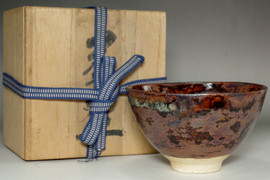Kato Shuntai (1802-1877) Antique Kizeto tea bowl #4929
- SKU:
- 4929
- Shipping:
- Free Shipping
- width: approx. 13.5cm (5 5⁄16in) x 12.5cm (4 59⁄64in)
- height: approx. 8cm (3 5⁄32in)
- weight: 245g
- condttion: small damaged
This tea bowl is a symbol of the deep tradition of Japanese ceramics. The creator, Kato Harutai (1802-1877), was an active potter in the late Edo period, and his works are known as supreme expressions of Japanese aesthetics and artisanal skill. The bowl is characterized by its gentle colors and natural shape, allowing one to feel the warmth and the personal touch imbued by the artist with each use. Its flavor deepens with use, and its texture becomes more familiar to the hand, aging with the user and weaving a new narrative over time.
Kato Shuntai (1802-1877)
A late Edo period ceramist from Seto. Born into the family of an Akazu potter, his childhood name was Soshiro. Excelling in ceramics from a young age, he followed in his father’s footsteps at the age of 15, beginning to create Ofukei-yaki in 1816. He is said to have received the sobriquet “Shuntai” from Nariharu Tokugawa, the 11th generation Daimyo of Owari-han (Nagoya), at the age of around 30. In response to Tamikichi Kato, a creator of Seto porcelain, Shuntai added the techniques of red painting, Shino-yaki, and Oribe-yaki to his works, and he also excelled at the Mugiwarade style, in which red, white and black designs are applied to the ceramic before baking. In Seto-yaki, there was a traditional style of pottery known as "Hongyo," and Shuntai was one of the last true craftsmen in that tradition. Signing the characters of his name in the bottom of his creations, he bragged about his position as a traditional artisan.
Kizeto
Kizeto emerged from the tawny brown Koseto (old seto) style of the Muromachi period, and unlike Shino lacquerware that had its beginnings in the Momoyama period, the Kizeto of the Momoyama period was especially beautiful with a captivating charm; since antiquity masters of the tea ceremony valued both “Aburagete” and “Ayamete” for their high quality, matte appearance, and grainy texture.
Although most were originally made for Mukozuke (one of the side dishes) and treated as tea bowls, there do exist some that were made to be tea bowls.
For Kizeto, when the clay is half-dried lines are drawn on with a twig or piece of bamboo, and the side is struck with copper chalcanthite. Copper chalcanthite turns green when baked via oxidation, a special trait of Kizeto that pairs well with scorch marks.
















